2012 RENAULT WIND ROADSTER fuel reserve
[x] Cancel search: fuel reservePage 48 of 185
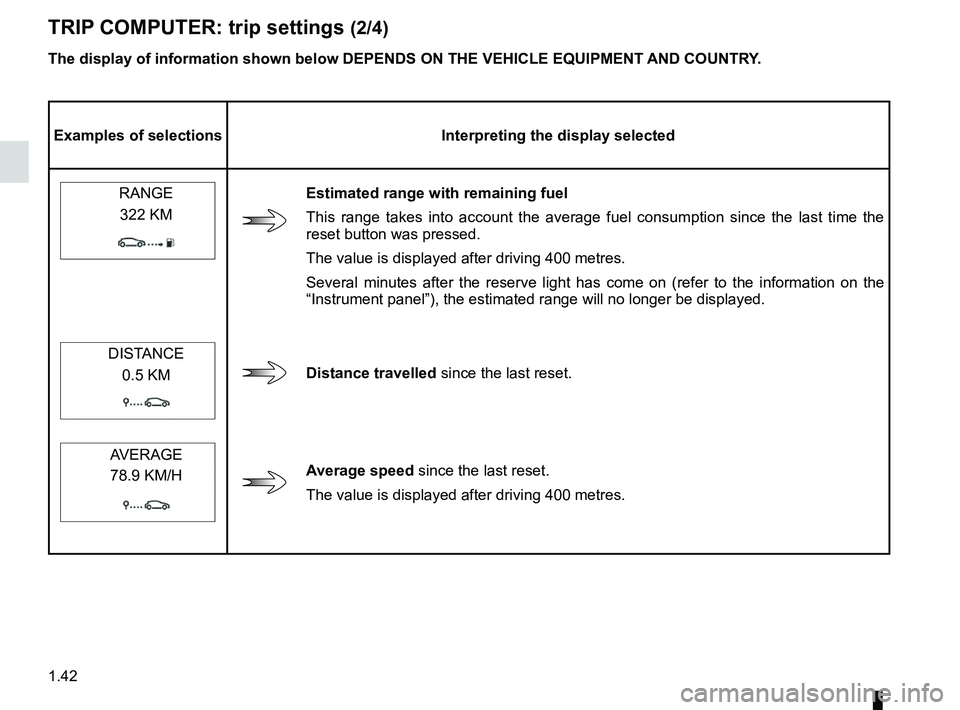
1.42
ENG_UD25519_2
Ordinateur de bord : paramètres de voyage (E33 - X33 - Renault)
ENG_NU_865-6_E33_Renault_1
Jaune NoirNoir texte
TRIp COMpUTER: trip settings (2/4)
The display of information shown below DEpENDS ON THE VEHICLE EQUIpMENT AND COUNTRY.
Examples of selections Interpreting the display selected
RANGE
Estimated range with remaining fuel
This range takes into account the average fuel consumption since the last time the
reset button was pressed.
The value is displayed after driving 400 metres.
Several minutes after the reserve light has come on (refer to the information on the
“Instrument panel”), the estimated range will no longer be displayed.
322 KM
DISTANCE
Distance travelled
since the last reset.
0.5 KM
AVERAGEAverage speed since the last reset.
The value is displayed after driving 400 metres.
78.9 KM/H
Page 72 of 185
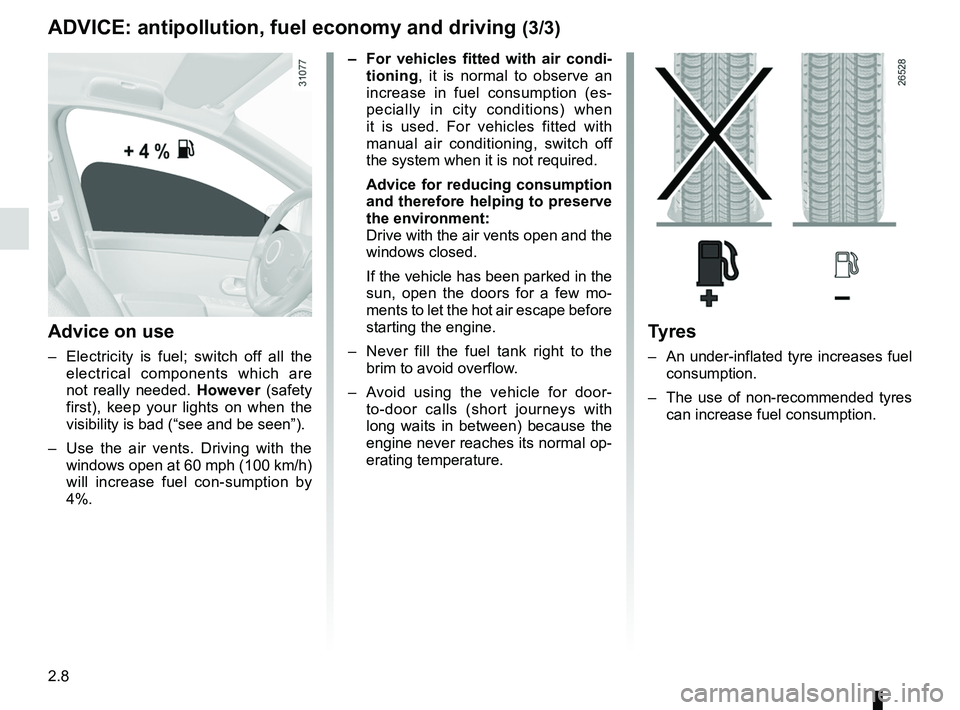
tyres ....................................................................... (current page)
2.8
ENG_UD20551_2
CONSEILS : antipollution, économies de carburant, conduite (E33 - X3\
3 - Renault)
ENG_NU_865-6_E33_Renault_2
ADVIcE: antipollution, fuel economy and driving (3/3)
Advice on use
– Electricity is fuel; switch off all the
electrical components which are
not really needed. however (safety
first), keep your lights on when the
visibility is bad (“see and be seen”).
– Use the air vents. Driving with the
windows open at 60 mph (100 km/h)
will increase fuel con -sumption by
4%.
– For vehicles fitted with air condi -
tioning , it is normal to observe an
increase in fuel consumption (es -
pecially in city conditions) when
it is used. For vehicles fitted with
manual air conditioning, switch off
the system when it is not required.
Advice for reducing consumption
and therefore helping to preserve
the environment:
Drive with the air vents open and the
windows closed.
If the vehicle has been parked in the
sun, open the doors for a few mo -
ments to let the hot air escape before
starting the engine.
– Never fill the fuel tank right to the
brim to avoid overflow.
– Avoid using the vehicle for door -
to-door calls (short journeys with
long waits in between) because the
engine never reaches its normal op-
erating temperature.
t yres
– An under-inflated tyre increases fuel
consumption.
– The use of non-recommended tyres
can increase fuel consumption.
Page 73 of 185
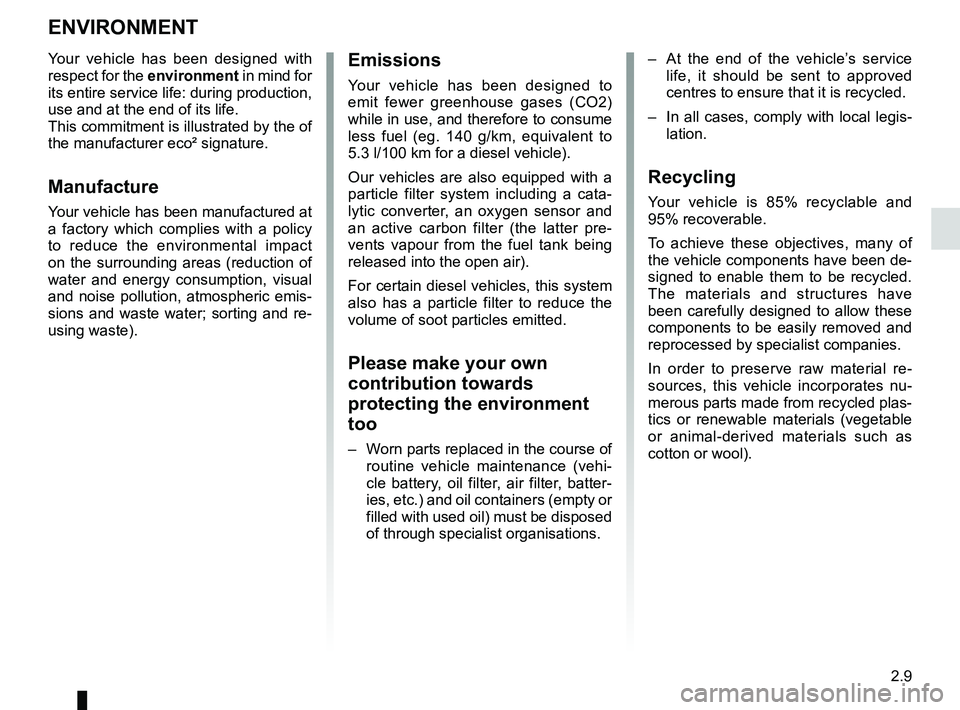
environment .......................................... (up to the end of the DU)
2.9
ENG_UD25716_1
Environnement (sans marque) (X44 - X45 - X77 - X81 - X85 - X90 - X91 \
- X83 - X61 - TEST - X95 - J95 - R95 - F90 Ph2 - X33 - X47 - X43 - X38 - H79 - X62 - X32 -\
X09 -
ENG_NU_865-6_E33_Renault_2
Environment
ENVIRoNMENt
Emissions
Your vehicle has been designed to
emit fewer greenhouse gases (CO2)
while in use, and therefore to consume
less fuel (eg. 140 g/km, equivalent to
5.3 l/100 km for a diesel vehicle).
Our vehicles are also equipped with a
particle filter system including a cata -
lytic converter, an oxygen sensor and
an active carbon filter (the latter pre -
vents vapour from the fuel tank being
released into the open air).
For certain diesel vehicles, this system
also has a particle filter to reduce the
volume of soot particles emitted.
Please make your own
contribution towards
protecting the environment
too
– Worn parts replaced in the course of
routine vehicle maintenance (vehi -
cle battery, oil filter, air filter, batter -
ies, etc.) and oil containers (empty or
filled with used oil) must be disposed
of through specialist organisations. –
At the end of the vehicle’s service
life, it should be sent to approved
centres to ensure that it is recycled.
– In all cases, comply with local legis -
lation.
Recycling
Your vehicle is 85% recyclable and
95% recoverable.
To achieve these objectives, many of
the vehicle components have been de-
signed to enable them to be recycled.
The materials and structures have
been carefully designed to allow these
components to be easily removed and
reprocessed by specialist companies.
In order to preserve raw material re -
sources, this vehicle incorporates nu -
merous parts made from recycled plas-
tics or renewable materials (vegetable
or animal-derived materials such as
cotton or wool).
Your vehicle has been designed with
respect for the
environment in mind for
its entire service life: during production,
use and at the end of its life.
This commitment is illustrated by the of
the manufacturer eco² signature.Manufacture
Your vehicle has been manufactured at
a factory which complies with a policy
to reduce the environmental impact
on the surrounding areas (reduction of
water and energy consumption, visual
and noise pollution, atmospheric emis-
sions and waste water; sorting and re-
using waste).
Page 102 of 185
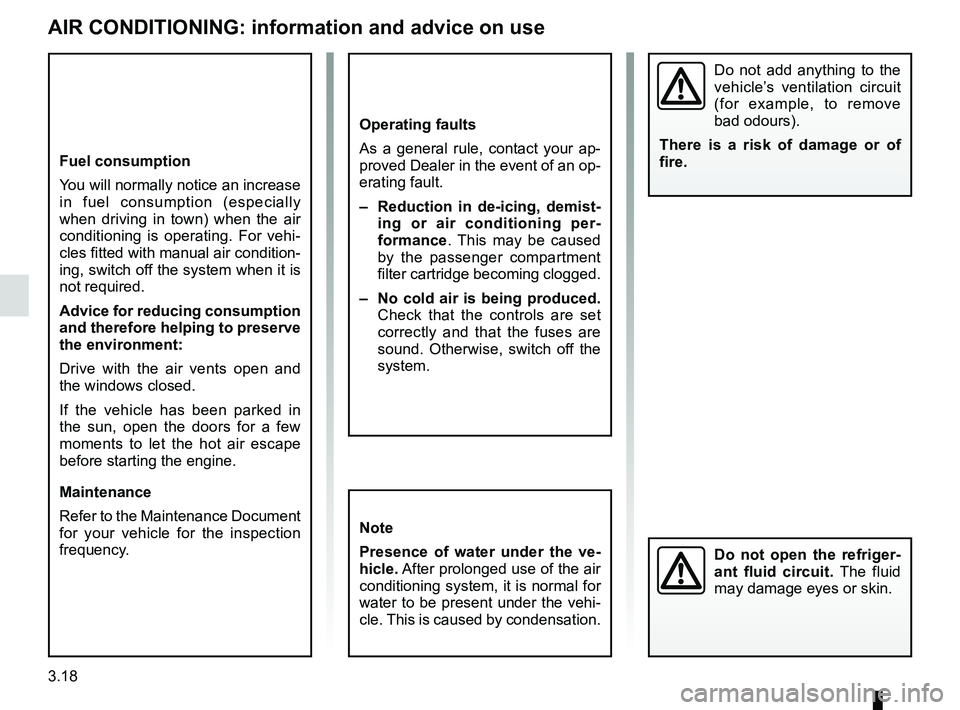
air conditioning ..................................... (up to the end of the DU)
heating system ..................................... (up to the end of the DU)
air conditioning ..................................... (up to the end of the DU)
temperature regulation ......................... (up to the end of the DU)
ventilation ............................................. (up to the end of the DU)
heating and air conditioning system ...................... (current page)
3.18
ENG_UD11524_2
Air conditionné : informations et conseils d’utilisation (X77 ph2\
- Renault)
ENG_NU_865-6_E33_Renault_3
aiR ConDitioning: information and advice on use
Fuel consumption
You will normally notice an increase
in fuel consumption (especially
when driving in town) when the air
conditioning is operating. For vehi -
cles fitted with manual air condition -
ing, switch off the system when it is
not required.
advice for reducing consumption
and therefore helping to preserve
the environment:
Drive with the air vents open and
the windows closed.
If the vehicle has been parked in
the sun, open the doors for a few
moments to let the hot air escape
before starting the engine.
Maintenance
Refer to the Maintenance Document
for your vehicle for the inspection
frequency.
Do not open the refriger -
ant fluid circuit. The fluid
may damage eyes or skin.
note
Presence of water under the ve -
hicle. After prolonged use of the air
conditioning system, it is normal for
water to be present under the vehi-
cle. This is caused by condensation.
operating faults
As a general rule, contact your ap-
proved Dealer in the event of an op-
erating fault.
– Reduction in de-icing, demist -
ing or air conditioning per -
formance . This may be caused
by the passenger compartment
filter cartridge becoming clogged.
– no cold air is being produced.
Check that the controls are set
correctly and that the fuses are
sound. Otherwise, switch off the
system.
Do not add anything to the
vehicle’s ventilation circuit
(for example, to remove
bad odours).
t here is a risk of damage or of
fire.
Page 146 of 185
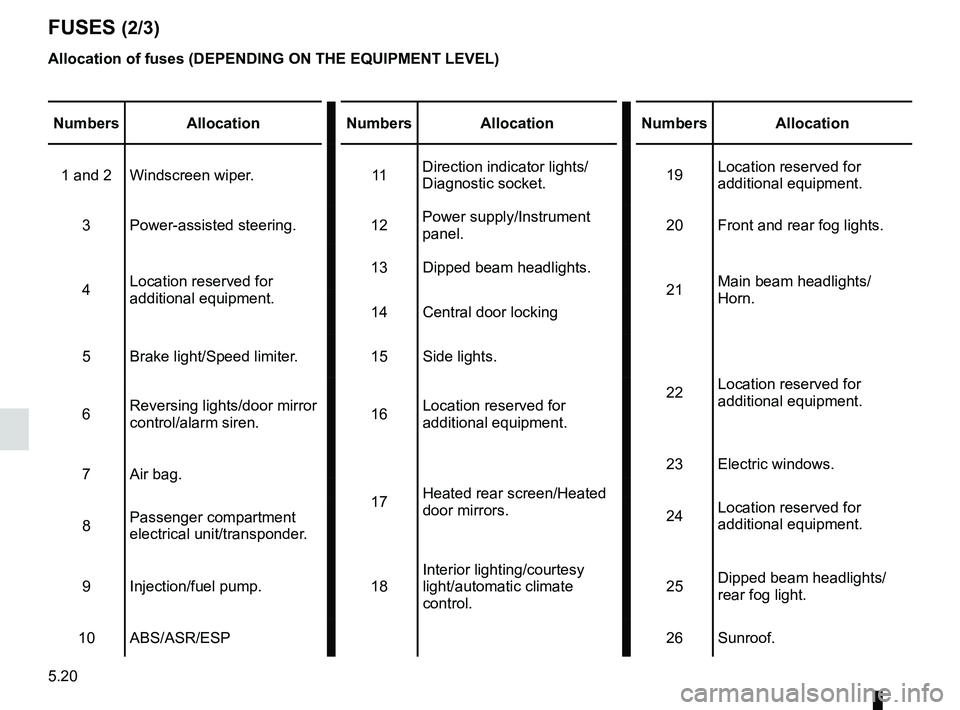
5.20
ENG_UD24358_4
Fusibles (E33 - X33 - Renault)
ENG_NU_865-6_E33_Renault_5
Jaune NoirNoir texte
allocation of fuses (dePendIng On tHe eQuIPment LeVeL)
Fuses (2/3)
numbers allocation numbersallocation numbersallocation
1 and 2 Windscreen wiper. 11Direction indicator lights/
Diagnostic socket. 19Location reserved for
additional equipment.
3 Power-assisted steering. 12Power supply/Instrument
panel. 20
Front and rear fog lights.
4 Location reserved for
additional equipment. 13
Dipped beam headlights.
21Main beam headlights/
Horn.
14 Central door locking
5 Brake light/Speed limiter. 15Side lights.
22Location reserved for
additional equipment.
6 Reversing lights/door mirror
control/alarm siren. 16Location reserved for
additional equipment.
7 Air bag.
17Heated rear screen/Heated
door mirrors. 23
Electric windows.
24 Location reserved for
additional equipment.
8 Passenger compartment
electrical unit/transponder.
9 Injection/fuel pump. 18Interior lighting/courtesy
light/automatic climate
control. 25
Dipped beam headlights/
rear fog light.
10 ABS/ASR/ESP 26Sunroof.